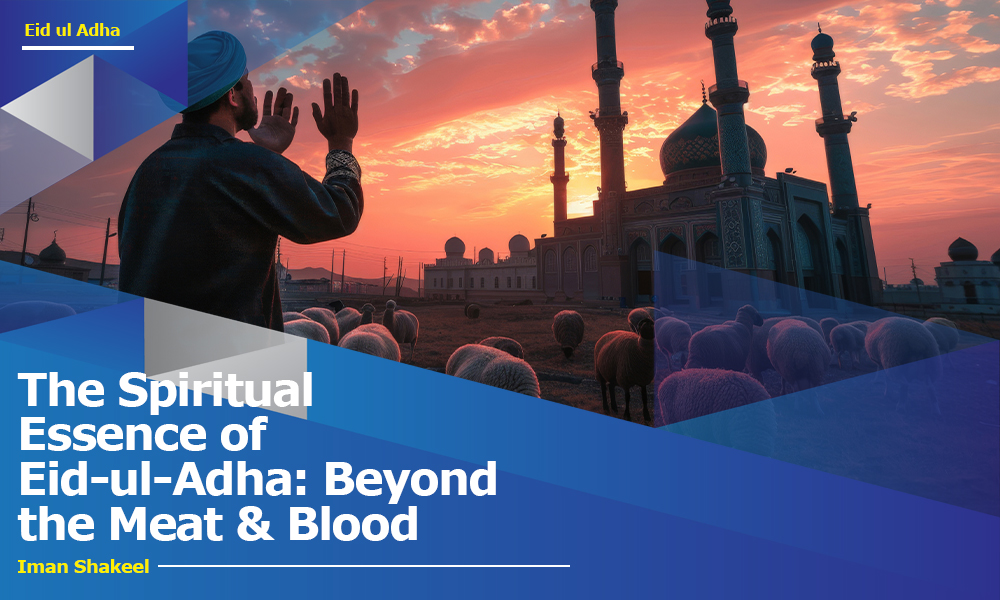During Hajj, Muslims reflect on Prophet Ibrahim’s trials, particularly his readiness to sacrifice his son following a divine dream. Ibrahim conveyed his dream to Isma’il, who agreed to the sacrifice. Allah replaced Isma’il with a ram, thus affirming Ibrahim’s loyalty and faith.
On Eid-ul-Adha, Muslims globally gather for morning prayers followed by a sermon at their local mosques. The tradition of sacrificing an animal—be it a sheep, camel, or goat—honours Ibrahim’s devotion. The sacrificed meat is enjoyed in various delicacies, yet the essence of this ritual lies in understanding its deeper significance. Allah emphasises this in Surah Hajj:
لَن يَنَالَ ٱللَّهَ لُحُومُهَا وَلَا دِمَآؤُهَا وَلَـٰكِن يَنَالُهُ ٱلتَّقْوَىٰ مِنكُمْ ۚ كَذَٰلِكَ سَخَّرَهَا لَكُمْ لِتُكَبِّرُوا۟ ٱللَّهَ عَلَىٰ مَا هَدَىٰكُمْ ۗ وَبَشِّرِ ٱلْمُحْسِنِينَ (٣٧)
Historically, pre-Islamic Arabs would place the meat of their sacrifices and sprinkle the blood on the Kaaba. The companions of the Prophet Muhammad (peace be upon him) initially believed they had the right to continue this practice. However, Allah clarified through revelation that it is not the physical aspects of sacrifice that matter but the piety and sincerity behind it.
The hadith further emphasizes this divine message:
“Allah does not look to your appearance or your colours, but He looks to your hearts and deeds.”
(And give glad tidings to the doers of good.) means, `give good news, O Muhammad, to those who do good,’ i.e., whose deeds are good and who remain within the limits prescribed by Allah, who follow that which has been prescribed for them, who believe in the Messenger and follow that which he has conveyed from his Lord.
This verse from Surah Hajj prescribes a very important condition for the sacrifice made in worshipping Allah. A sacrifice is acceptable to Allah only if accompanied by piety and sincerity. Although the act of sacrifice is symbolic, its true value lies in the devotion behind it. This was also meant to condemn the ritual of the days of ignorance when the Arabs took the flesh to the Kabah and smeared its walls with the blood of the sacrificed animal.
“That you may glorify Allah” at the time of sacrifice verbally also to acknowledge that the animals belong to Allah and no one else. One of the sentences uttered at the time of sacrifice is “Allahumma minka wa laka (O Allah, this animal is yours and is presented to you).
It’s important to note that the command for sacrifice in verses 36 and 37 is not exclusive to pilgrims or to Makkah during Hajj. It is a general directive for all well-off Muslims. They are enjoined to express gratitude to Allah, who has provided these animals for human benefit. Therefore, they are required to sacrifice the animals during these days so that they may spiritually join those who go to Makkah to perform Hajj.
The practice of sacrifice, a Sunnah Mustahabbah (recommended Sunnah), is supported by numerous hadiths. Ibn `Umar said, “The Messenger of Allah ﷺ continued to offer sacrifice for ten years.” (At-Tirmidhi). Abu Ayyub said: “At the time of the Messenger of Allah ﷺ, a man would sacrifice a sheep on behalf of himself and all the members of his household, and they would eat from it and feed others, until the people started boasting by sacrificing more than one and things reached the stage that you see now.” (At-Tirmidhi).
Additional hadiths underscore the significance of sacrifice:
(1) The one who does not perform sacrifice, even though he can, should not join us in the Eid Prayer. (Musnad Ahmad, Ibn Majah).
(2) According to a tradition reported by Ibn Umar, the Prophet (peace be upon him) dwelt at Al-Madinah for ten years and performed sacrifice every year. (Tirmizi).
(3) According to Anas, the Prophet (peace be upon him) said: “The one who sacrificed an animal before the Eid Prayer should offer another sacrifice; but the one who sacrificed his animal after the Eid Prayer did the right thing and followed the way of the Muslims.” (Bukhari).
In conclusion, Eid-ul-Adha is a profound celebration emphasising faith, obedience, and the essence of piety in worship. It is a time for Muslims to reflect on their devotion to Allah and to honour the spirit of sacrifice that lies at the heart of their faith.
- Livestock is a major income source for rural poor.
- Prohibiting animal sacrifice affects income, causing unemployment.
- 20.5 million people in India depend on the livestock business.
- 77% of India’s population consumes meat (NFHS-5).
- Banning meat consumption infringes on the right to food.
- The Indian cattle slaughter business supplies hides and skins worth USD 5.5 billion for the leather industry.
- Provides raw materials for manufacturing soap, toothpaste, buttons, paintbrushes, surgical stitches, musical instruments.
- Generates direct and indirect employment for about 22 lakh people.
- Leather industry employment: 35 lakh people.
- Livestock supports two-thirds of rural communities.
- Employs 8.8% of India’s total population.
- Critical for communities like the Bakarwals.
- Major income source for rural areas, aiding 20.5 million residents.
- Peak animal trading during the festival boosts rural economy.
- Stimulates allied businesses: leather, transportation, farming, tanning, footwear, clothing.
- Wealth redistribution from rich to poor through animal purchase and fodder.
- Meat is divided into three parts: for relatives/friends/neighbours, for the poor/needy, for household consumption.
- In Mecca, meat from Haajis’ sacrifices helps 30 million poor people in 27 countries.
- Promotes social interaction, cooperation, and brotherhood by sharing meat.
- The impact of cash distribution on the poor is relatively low compared to animal sacrifice. Animal sacrifice causes a wider circulation of wealth and multiplies.
- Cash transfers often have drawbacks: Women and children rarely benefit.
(Data credits: Abid Faheem/Nous Network:https://www.thenousnetwork.com/eid-ul-adha-debunking-myths-and-exploring-socio-economic-significance/


Thank you very much for the fantastic portrayal. May our prayers and sacrifices be accepted by the all-powerful deity.
Ameen! Jazakillah for your encouraging words. ♥️